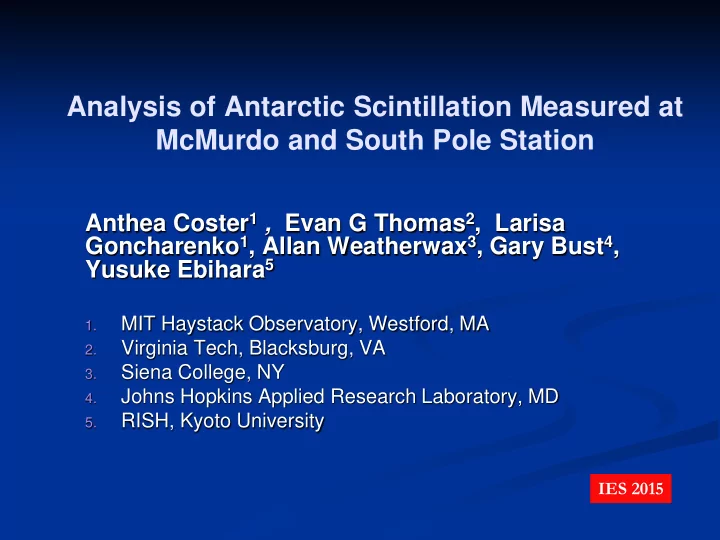

Analysis of Antarctic Scintillation Measured at McMurdo and South Pole Station Anthea Coster 1 , Evan G Thomas 2 , Larisa Goncharenko 1 , Allan Weatherwax 3 , Gary Bust 4 , Yusuke Ebihara 5 MIT Haystack Observatory, Westford, MA 1. Virginia Tech, Blacksburg, VA 2. Siena College, NY 3. Johns Hopkins Applied Research Laboratory, MD 4. RISH, Kyoto University 5. IES 2015
OUTLINE Introduction 17 March 2013 New TEC/ Scintillation inputs into Madrigal
Map of GPS receivers
18:00-19:20 UT
Scintillation - GNSS Ionospheric irregularities cause rapid fluctuations of radio signal amplitude and phase, called scintillation Issues with GNSS receivers measuring amplitude scintillation measurements in polar regions Issues of loss of lock issues with certain receivers
Where Scintillation is Observed Auroral/Polar Cap 1) Dayside: Phase scintillation is observed on the dayside within a tongue of ionization (TOI) and dayside aurora (cusp). 2) Nightside: scintillation is collocated with (a) strong post-midnight return convection (TOI) and (b) auroral breakups in pre-midnight sector. Subauroral latitudes 3) Scintillation maps to the poleward edge of main trough and is collocated with subauroral polarization stream (SAPS) and storm-enhanced plasma density (SED).
Location of GPS scintillation receivers in Antarctica: South Pole and McMurdo
OUTLINE Introduction 17 March 2013 New TEC/ Scintillation inputs into Madrigal
17 Mar 2013 Conditions 17 Mar 2013
OUTLINE Introduction 17 March 2013 New TEC/ Scintillation inputs into Madrigal
South Pole Phase Scintillation > 0.3 Counts per Day 2013
South Pole Phase Scintillation > 0.3 Counts per Day 2013 versus Ap
South Pole is a unique location where we can observe both the nightside aurora (substorm) and the dayside aurora (cusp).
Nighttime Aurora - Substorms
01:40 UT
1:56
2:00
2:12
2:23
Summary Presented case study of Antarctic scintillation associated with 17 March 2013 storm McMurdo and South Pole scintillation data now available through Madrigal. Capability of overlaying South Pole scintillation data onto auroral imaging data will be available in Madrigal soon.
Recommend
More recommend